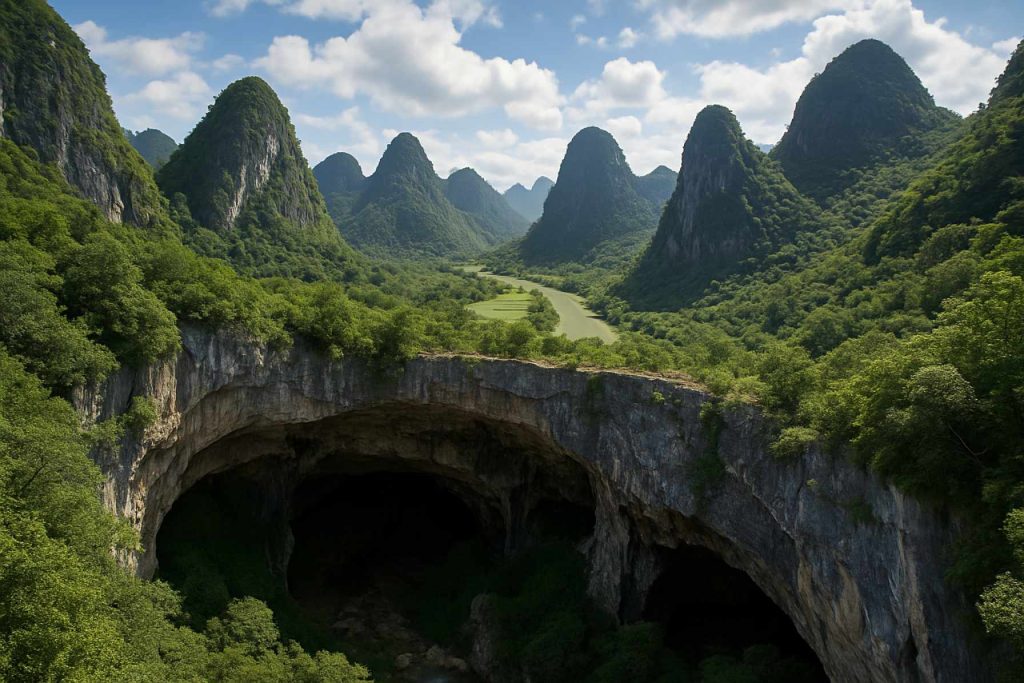
Karst Topography Explained: The Science, Wonders, and Future of Earth’s Most Mysterious Landscapes. Discover How Water Shapes Caves, Sinkholes, and Unique Ecosystems Beneath Our Feet. (2025)
- Introduction to Karst Topography: Definition and Global Distribution
- Geological Processes Behind Karst Formation
- Iconic Karst Landscapes: Notable Sites and Their Significance
- Hydrology of Karst: Aquifers, Springs, and Water Flow
- Biodiversity in Karst Ecosystems: Unique Flora and Fauna
- Human Interaction: Settlement, Agriculture, and Resource Use
- Risks and Hazards: Sinkholes, Groundwater Contamination, and Land Subsidence
- Technological Advances in Karst Mapping and Exploration
- Climate Change Impacts and Conservation Strategies
- Future Outlook: Public Interest, Research Trends, and Projected Growth (Estimated 15% increase in scientific publications and eco-tourism interest by 2030, per usgs.gov and unesco.org)
- Sources & References
Introduction to Karst Topography: Definition and Global Distribution
Karst topography refers to a distinctive landscape formed primarily by the dissolution of soluble rocks, such as limestone, dolomite, and gypsum. This geological process, known as chemical weathering, results in unique surface and subsurface features, including sinkholes, caves, disappearing streams, and underground drainage systems. The term “karst” originates from the Kras region (also known as Karst) in Slovenia and northeastern Italy, where such landscapes were first studied in detail. The defining characteristic of karst terrain is the predominance of solutional processes over mechanical erosion, leading to the development of irregular terrain with little surface water, as precipitation rapidly infiltrates through fractures and conduits in the bedrock.
Globally, karst landscapes are widespread and occur on every continent except Antarctica. They are estimated to cover approximately 15% of the Earth’s land surface and provide drinking water for nearly a quarter of the world’s population. Major karst regions include the extensive limestone plateaus of southern China, the Dinaric Alps in the Balkans, the Appalachian Mountains in the United States, the Yucatán Peninsula in Mexico, and parts of Australia and Africa. Each of these regions exhibits characteristic karst features shaped by local climate, geology, and hydrology.
The global distribution of karst is closely linked to the presence of thick, soluble rock formations and sufficient rainfall to drive dissolution processes. In humid climates, karstification tends to be more pronounced, resulting in dramatic landforms such as tower karst and large cave systems. In contrast, arid regions may display subdued karst features due to limited water availability. The study and mapping of karst areas are crucial for water resource management, as karst aquifers are highly productive but vulnerable to contamination due to rapid groundwater flow and limited natural filtration.
International organizations such as the United Nations Educational, Scientific and Cultural Organization (UNESCO) and the International Union of Geological Sciences (IUGS) recognize the scientific and ecological significance of karst landscapes. Several karst regions, including the South China Karst and the Škocjan Caves in Slovenia, are designated as UNESCO World Heritage Sites due to their outstanding geological value and biodiversity. Ongoing research and conservation efforts aim to better understand karst processes and protect these unique environments for future generations.
Geological Processes Behind Karst Formation
Karst topography is a distinctive landscape shaped primarily by the dissolution of soluble rocks, such as limestone, dolomite, and gypsum. The geological processes behind karst formation are complex and involve a combination of chemical, physical, and sometimes biological mechanisms. The primary driver is the chemical weathering of carbonate rocks, which occurs when slightly acidic water—mainly rainwater mixed with atmospheric carbon dioxide—percolates through soil and bedrock. This process forms carbonic acid, which reacts with calcium carbonate in limestone, gradually dissolving the rock and enlarging fractures and bedding planes.
Over time, these dissolution processes create a variety of characteristic landforms, including sinkholes (dolines), disappearing streams, caves, and underground drainage systems. The initial stage of karstification begins with the infiltration of acidic water into small cracks and joints in the bedrock. As dissolution progresses, these pathways widen, allowing more water to flow through and accelerating the process. This positive feedback loop leads to the development of extensive subterranean networks and, eventually, the collapse of surface layers, forming sinkholes and depressions.
The rate and extent of karstification depend on several factors, including the purity and solubility of the bedrock, the availability of water, climate, vegetation cover, and the presence of natural acids. For example, regions with high rainfall and abundant vegetation tend to have more active karst processes due to increased production of organic acids and greater water infiltration. Additionally, the presence of faults and fractures in the rock enhances water movement and accelerates dissolution.
Biological activity also plays a role in karst formation. Plant roots and soil microorganisms produce organic acids that further contribute to the dissolution of carbonate rocks. In some cases, the action of certain bacteria can enhance the breakdown of minerals, influencing the development of karst features.
Globally, karst landscapes are significant for their unique hydrology and ecology. They often serve as major aquifers, supplying drinking water to millions of people. However, their complex underground drainage systems make them particularly vulnerable to contamination and difficult to manage. Organizations such as the United States Geological Survey and the United Nations Educational, Scientific and Cultural Organization (UNESCO) study and monitor karst regions to better understand their formation, distribution, and environmental significance.
In summary, the geological processes behind karst formation are primarily driven by the chemical dissolution of soluble rocks, facilitated by water and natural acids, and influenced by climatic, biological, and structural factors. These processes result in the development of some of the world’s most fascinating and ecologically important landscapes.
Iconic Karst Landscapes: Notable Sites and Their Significance
Karst topography, characterized by distinctive landforms such as sinkholes, caves, and underground rivers, is found across the globe and has given rise to some of the world’s most iconic landscapes. These sites are not only geological wonders but also hold ecological, cultural, and scientific significance.
One of the most renowned karst regions is the Guilin and Yangshuo area in southern China. The dramatic limestone towers and lush river valleys of this region have inspired Chinese art and poetry for centuries. The area’s unique geomorphology is the result of millions of years of limestone dissolution, creating a landscape of steep hills, caves, and underground streams. The United Nations Educational, Scientific and Cultural Organization (UNESCO) recognizes the South China Karst as a World Heritage Site, highlighting its outstanding natural beauty and geological value.
In Europe, the Karst Plateau in Slovenia and northeastern Italy is the namesake of karst topography. This region features classic karst phenomena, including extensive cave systems such as the Škocjan Caves, which are also listed as a UNESCO World Heritage Site. The plateau’s porous limestone has led to the development of underground rivers and large sinkholes, making it a key area for the study of karst processes. The Geological and Mining Institute of Spain (IGME) and other European geological organizations have conducted extensive research in this region, contributing to the global understanding of karst dynamics.
The Mammoth Cave System in Kentucky, USA, is the world’s longest known cave system, with more than 400 miles of surveyed passageways. Managed by the National Park Service, Mammoth Cave National Park is a UNESCO World Heritage Site and an International Biosphere Reserve. The cave’s vast network of tunnels and chambers provides critical habitat for unique and endangered species, and its study has advanced knowledge of subterranean ecosystems and groundwater flow.
Other notable karst landscapes include the Phong Nha-Ke Bang National Park in Vietnam, home to some of the world’s largest caves, and the Yucatán Peninsula in Mexico, famous for its cenotes—natural sinkholes that expose the region’s extensive underground rivers. These sites are vital for biodiversity, water resources, and cultural heritage, and are often protected by national and international conservation bodies.
The significance of these iconic karst landscapes extends beyond their visual appeal. They serve as natural laboratories for geological and hydrological research, support unique ecosystems, and provide resources and inspiration for local communities. Their preservation is a priority for organizations such as International Union for Conservation of Nature (IUCN) and UNESCO, ensuring that these remarkable environments continue to benefit science and society.
Hydrology of Karst: Aquifers, Springs, and Water Flow
Karst topography is characterized by distinctive landforms such as sinkholes, caves, and disappearing streams, all of which are the result of the dissolution of soluble rocks—primarily limestone, dolomite, and gypsum. This unique geological setting profoundly influences hydrology, giving rise to complex aquifer systems, abundant springs, and highly variable water flow patterns. Understanding the hydrology of karst is essential for water resource management, environmental protection, and hazard mitigation in regions underlain by these rocks.
Karst aquifers are among the most productive groundwater reservoirs in the world, supplying drinking water to hundreds of millions of people. Unlike typical porous media aquifers, karst aquifers are defined by a network of enlarged fractures, conduits, and caves that allow water to move rapidly through the subsurface. This conduit-dominated flow system results in high hydraulic conductivity and rapid recharge and discharge rates. However, it also means that karst aquifers are highly vulnerable to contamination, as pollutants can travel quickly and with little natural filtration. The United States Geological Survey and the United Nations Educational, Scientific and Cultural Organization (UNESCO) both recognize the global significance and sensitivity of karst groundwater systems.
Springs are a hallmark of karst landscapes, often emerging where groundwater flows from conduits to the surface. These springs can range from small seeps to large, high-discharge features such as first-magnitude springs, which can release thousands of liters per second. The variability in spring flow is closely tied to precipitation events and the rapid transmission of water through the karst system. This dynamic response can lead to dramatic fluctuations in water levels and quality, especially after heavy rainfall, when surface contaminants may be quickly transported to springs.
Water flow in karst terrains is notably complex. Surface water often disappears into sinkholes or swallow holes, entering the subsurface and traveling through unpredictable pathways before re-emerging at springs or other outlets. This process, known as “swallet-to-spring” flow, can make tracing water movement and managing water resources particularly challenging. The International Union of Geodesy and Geophysics and its affiliated bodies have emphasized the need for specialized hydrogeological studies and monitoring in karst regions to better understand these processes.
In summary, the hydrology of karst topography is defined by rapid, conduit-driven groundwater flow, prolific and variable springs, and a high susceptibility to contamination. Effective management of karst water resources requires a detailed understanding of these unique hydrological characteristics, as recognized by leading scientific and environmental organizations worldwide.
Biodiversity in Karst Ecosystems: Unique Flora and Fauna
Karst topography, characterized by distinctive landforms such as sinkholes, caves, and underground rivers, arises from the dissolution of soluble rocks like limestone, dolomite, and gypsum. These unique geological features create highly specialized habitats that support remarkable biodiversity, including many endemic and rare species. The complex interplay of hydrology, geology, and microclimates in karst landscapes fosters ecological niches that are often isolated from surrounding environments, leading to the evolution of unique flora and fauna.
Karst ecosystems are globally significant for their biological richness. The subterranean environments—caves, fissures, and underground streams—harbor specialized organisms adapted to perpetual darkness, high humidity, and limited food resources. Troglobites, or obligate cave dwellers, include blind fish, cave-adapted crustaceans, and unique invertebrates. For example, the olm (Proteus anguinus), a blind aquatic salamander, is endemic to the Dinaric Karst of the western Balkans and is considered a flagship species for subterranean biodiversity. Surface karst habitats, such as limestone pavements and rocky outcrops, support rare plant communities, including calcicole (lime-loving) species and endemic orchids.
The isolation of karst habitats often results in high levels of endemism. Many species found in karst regions are not present anywhere else on Earth. For instance, the Edwards Plateau in Texas, a prominent karst region, is home to several endemic plant species and endangered cave invertebrates. Similarly, the Guilin Karst in China supports unique assemblages of ferns and mosses adapted to the thin soils and shaded microhabitats of limestone towers.
Karst systems also play a crucial role in supporting bat populations. Caves provide essential roosting and breeding sites for numerous bat species, some of which are threatened or endangered. Bats, in turn, contribute to ecosystem health through pollination, seed dispersal, and insect population control. The conservation of karst habitats is therefore vital for maintaining these ecological services.
Despite their ecological importance, karst ecosystems are highly vulnerable to human activities such as quarrying, groundwater extraction, pollution, and land-use change. The fragility of karst hydrology means that contaminants can rapidly spread through underground networks, threatening both biodiversity and water resources. Recognizing the significance of karst biodiversity, organizations such as the International Union for Conservation of Nature and the United Nations Educational, Scientific and Cultural Organization have designated several karst regions as protected areas or World Heritage Sites, underscoring the need for their conservation and sustainable management.
Human Interaction: Settlement, Agriculture, and Resource Use
Karst topography, characterized by distinctive landforms such as sinkholes, caves, disappearing streams, and rugged limestone terrain, profoundly influences human settlement, agriculture, and resource use. The unique geological and hydrological features of karst landscapes present both opportunities and challenges for communities living within these regions.
Settlement patterns in karst areas are often dictated by the availability of water and the stability of the ground. The presence of underground drainage systems and the potential for sudden ground subsidence due to sinkhole formation can make construction and infrastructure development risky. As a result, settlements are frequently located on more stable, non-karstic outcrops or along the margins of karst regions. In some cases, historical settlements have adapted to these challenges by developing specialized building techniques or by situating key infrastructure away from high-risk zones. The United States Geological Survey (USGS) notes that in the United States, significant portions of states like Florida, Kentucky, and Missouri are underlain by karst, influencing urban planning and land use decisions.
Agriculture in karst regions is shaped by the thin, rocky soils and the rapid drainage characteristic of these landscapes. While the fertile valleys and depressions (dolines) can support productive farming, the risk of soil erosion and nutrient leaching is high. Water management is a persistent challenge, as surface water can quickly disappear into subterranean channels, making irrigation difficult and increasing vulnerability to drought. Conversely, the presence of springs and underground aquifers can provide reliable water sources if managed sustainably. The Food and Agriculture Organization of the United Nations (FAO) highlights the need for careful land management in karst areas to prevent land degradation and protect water quality, as pollutants can rapidly enter groundwater systems through sinkholes and fissures.
Resource use in karst landscapes is diverse. Caves and underground rivers have historically provided shelter, water, and transportation routes. Today, karst aquifers are vital sources of drinking water for millions of people worldwide. However, these aquifers are highly susceptible to contamination due to the direct connection between surface and groundwater. Quarrying of limestone and other carbonate rocks is another significant economic activity, but it must be balanced with the need to preserve fragile karst ecosystems. Organizations such as the International Union for Conservation of Nature (IUCN) emphasize the importance of sustainable management practices to protect the unique biodiversity and hydrological functions of karst environments.
In summary, human interaction with karst topography requires a nuanced understanding of its geological and ecological dynamics. Effective settlement planning, sustainable agricultural practices, and responsible resource extraction are essential to ensure the long-term viability of communities and ecosystems in karst regions.
Risks and Hazards: Sinkholes, Groundwater Contamination, and Land Subsidence
Karst topography, characterized by distinctive landforms such as sinkholes, caves, and underground drainage systems, arises from the dissolution of soluble rocks like limestone, dolomite, and gypsum. While these landscapes are geologically fascinating, they also present significant risks and hazards to human populations and infrastructure. The three primary concerns associated with karst regions are sinkholes, groundwater contamination, and land subsidence.
Sinkholes are perhaps the most dramatic and immediate hazard in karst terrains. They form when the underlying soluble rock is dissolved by slightly acidic groundwater, creating underground voids. When the overlying material can no longer support itself, it collapses, forming a depression or hole at the surface. Sinkholes can develop gradually or suddenly, sometimes swallowing roads, buildings, and even entire neighborhoods. The unpredictability and rapid onset of sinkhole formation make them particularly dangerous in populated areas. According to the United States Geological Survey, regions in Florida, Texas, Alabama, Missouri, Kentucky, Tennessee, and Pennsylvania are especially prone to sinkhole activity due to their extensive karst landscapes.
Groundwater contamination is another significant risk in karst areas. The same features that make karst aquifers highly productive—such as rapid water flow through interconnected fractures and conduits—also make them vulnerable to pollution. Contaminants from agricultural runoff, industrial spills, or leaking septic systems can quickly enter the groundwater system, bypassing the natural filtration provided by soil and rock in non-karst environments. This rapid transport means that pollutants can spread over large distances and reach drinking water supplies with little warning. The United States Environmental Protection Agency highlights the challenges of protecting water quality in karst regions, noting that traditional groundwater protection strategies may be insufficient due to the unique hydrogeology of these systems.
Land subsidence in karst areas is often linked to both natural processes and human activities. The gradual dissolution of bedrock can cause the ground surface to sink over time, a process that may be exacerbated by excessive groundwater withdrawal or construction activities. Land subsidence can damage infrastructure, disrupt transportation networks, and increase the risk of flooding. The United States Geological Survey monitors subsidence in karst regions and reports that it can result in significant economic losses and pose long-term challenges for land use planning and development.
In summary, while karst topography supports unique ecosystems and provides valuable water resources, it also presents substantial risks. Effective management and mitigation strategies require a thorough understanding of karst processes and close collaboration between geologists, engineers, and policymakers to protect both people and the environment.
Technological Advances in Karst Mapping and Exploration
Technological advances have significantly transformed the mapping and exploration of karst topography, a landscape characterized by sinkholes, caves, and underground drainage systems formed primarily through the dissolution of soluble rocks such as limestone, dolomite, and gypsum. Traditional field-based methods, while foundational, often faced limitations due to the inaccessibility and complexity of subterranean karst features. In recent years, however, a suite of innovative technologies has enabled more precise, efficient, and comprehensive investigations of these unique terrains.
Remote sensing technologies, particularly Light Detection and Ranging (LiDAR), have become indispensable in karst studies. LiDAR systems, mounted on aircraft or drones, emit laser pulses to generate high-resolution, three-dimensional models of the Earth’s surface. This allows researchers to detect subtle surface depressions, sinkholes, and other karst features even beneath dense vegetation. The United States Geological Survey (USGS), a leading authority in geological research, has extensively utilized LiDAR for mapping karst landscapes, enabling the identification of features that were previously undetectable through conventional aerial photography.
Geophysical methods have also advanced, with ground-penetrating radar (GPR), electrical resistivity tomography (ERT), and seismic surveys providing non-invasive means to probe subsurface karst structures. These techniques help delineate voids, conduits, and cave systems, offering critical data for hazard assessment and groundwater management. The British Geological Survey (BGS), for example, employs such geophysical tools to map and monitor karst terrains in the United Kingdom, supporting infrastructure planning and environmental protection.
In addition, advances in Geographic Information Systems (GIS) have revolutionized the integration, analysis, and visualization of karst data. GIS platforms enable the synthesis of spatial datasets from remote sensing, geophysics, and field surveys, facilitating the modeling of karst aquifers and the prediction of sinkhole susceptibility. Organizations like the European Geosciences Union (EGU) promote the development and dissemination of GIS-based methodologies for karst research, fostering international collaboration and knowledge exchange.
Furthermore, the deployment of autonomous robotic systems and cave mapping technologies, such as 3D laser scanners and photogrammetry, has expanded the frontiers of subterranean exploration. These tools allow for the detailed documentation of cave morphology and hydrology, supporting both scientific inquiry and the preservation of fragile karst environments.
Collectively, these technological advances are enhancing our understanding of karst topography, improving risk management, and informing sustainable land and water use in karst regions worldwide.
Climate Change Impacts and Conservation Strategies
Karst topography, characterized by distinctive landforms such as sinkholes, caves, and underground drainage systems, is formed primarily through the dissolution of soluble rocks like limestone, dolomite, and gypsum. These landscapes are ecologically significant, supporting unique biodiversity and providing vital freshwater resources. However, karst systems are particularly sensitive to environmental changes, making them vulnerable to the impacts of climate change.
Climate change affects karst regions in several interconnected ways. Altered precipitation patterns, including increased frequency and intensity of storms or prolonged droughts, can disrupt the delicate hydrological balance of karst aquifers. Intense rainfall events may accelerate erosion and increase the risk of sinkhole formation, while droughts can reduce groundwater recharge, threatening water availability for both ecosystems and human use. Additionally, rising temperatures can influence the rate of chemical weathering, potentially altering the pace at which karst features develop or degrade.
Changes in climate also have cascading effects on the unique flora and fauna adapted to karst environments. Many cave-dwelling species are highly specialized and sensitive to shifts in temperature and humidity. As surface conditions change, these organisms may face habitat loss or altered food webs, increasing their risk of extinction. Furthermore, karst aquifers, which supply drinking water to nearly a quarter of the world’s population, are at heightened risk of contamination due to changes in land use and more frequent extreme weather events, which can transport pollutants rapidly through the porous rock.
Conservation strategies for karst landscapes in the face of climate change require a multifaceted approach. Protecting recharge zones from deforestation, urbanization, and pollution is critical to maintaining water quality and quantity. Integrated watershed management, which considers the entire hydrological cycle and land use practices, can help buffer karst systems against climate variability. Monitoring programs, often coordinated by national geological surveys and environmental agencies, are essential for tracking changes in groundwater levels, water quality, and ecosystem health.
International organizations such as the United Nations Educational, Scientific and Cultural Organization (UNESCO) play a pivotal role in promoting the conservation of karst landscapes through the designation of World Heritage Sites and Biosphere Reserves. These designations help raise awareness, foster research, and encourage the implementation of best management practices. Additionally, the International Union for Conservation of Nature (IUCN) provides guidance on the protection of karst biodiversity and the sustainable management of these fragile systems. Collaborative efforts between governments, scientific bodies, and local communities are essential to ensure the resilience of karst topography in a changing climate.
Future Outlook: Public Interest, Research Trends, and Projected Growth (Estimated 15% increase in scientific publications and eco-tourism interest by 2030, per usgs.gov and unesco.org)
The future outlook for karst topography research and public engagement is marked by a notable surge in both scientific inquiry and eco-tourism, driven by growing recognition of karst landscapes’ ecological, hydrological, and cultural significance. According to projections by the United States Geological Survey (USGS) and UNESCO, there is an estimated 15% increase in scientific publications and eco-tourism interest related to karst environments anticipated by 2030. This trend reflects a broader global movement toward understanding and preserving unique geological features, as well as leveraging their value for sustainable tourism and education.
Research trends in karst topography are increasingly interdisciplinary, integrating geology, hydrology, biology, and climate science. The complexity of karst systems—characterized by features such as sinkholes, caves, and underground rivers—demands advanced methods in remote sensing, geospatial analysis, and groundwater modeling. International collaborations are expanding, with organizations like UNESCO designating several karst regions as World Heritage Sites and Biosphere Reserves, thereby fostering cross-border research initiatives and conservation efforts. The USGS continues to prioritize karst aquifer studies, given their critical role in global freshwater supply and vulnerability to contamination.
Public interest in karst landscapes is also on the rise, fueled by increased awareness of their ecological importance and recreational potential. Eco-tourism centered on karst features—such as cave exploration, guided hikes, and educational tours—has become a significant driver of local economies in regions with prominent karst formations. This growth is supported by efforts from governmental and non-governmental organizations to promote responsible tourism and environmental stewardship. For example, UNESCO’s Global Geoparks program highlights karst sites as key destinations for sustainable tourism, education, and community engagement.
Looking ahead to 2025 and beyond, the convergence of scientific research and public interest is expected to yield substantial benefits for karst conservation and management. Enhanced funding opportunities, technological advancements, and policy support are likely to accelerate discoveries and improve the resilience of karst ecosystems. The projected increase in publications and eco-tourism not only underscores the enduring fascination with these landscapes but also signals a commitment to their long-term protection and sustainable use, as emphasized by leading authorities such as USGS and UNESCO.
Sources & References
- United Nations Educational, Scientific and Cultural Organization (UNESCO)
- International Union of Geological Sciences (IUGS)
- United Nations Educational, Scientific and Cultural Organization
- United Nations Educational, Scientific and Cultural Organization (UNESCO)
- Geological and Mining Institute of Spain (IGME)
- National Park Service
- International Union for Conservation of Nature (IUCN)
- International Union of Geodesy and Geophysics
- International Union for Conservation of Nature
- Food and Agriculture Organization of the United Nations
- British Geological Survey
- European Geosciences Union



